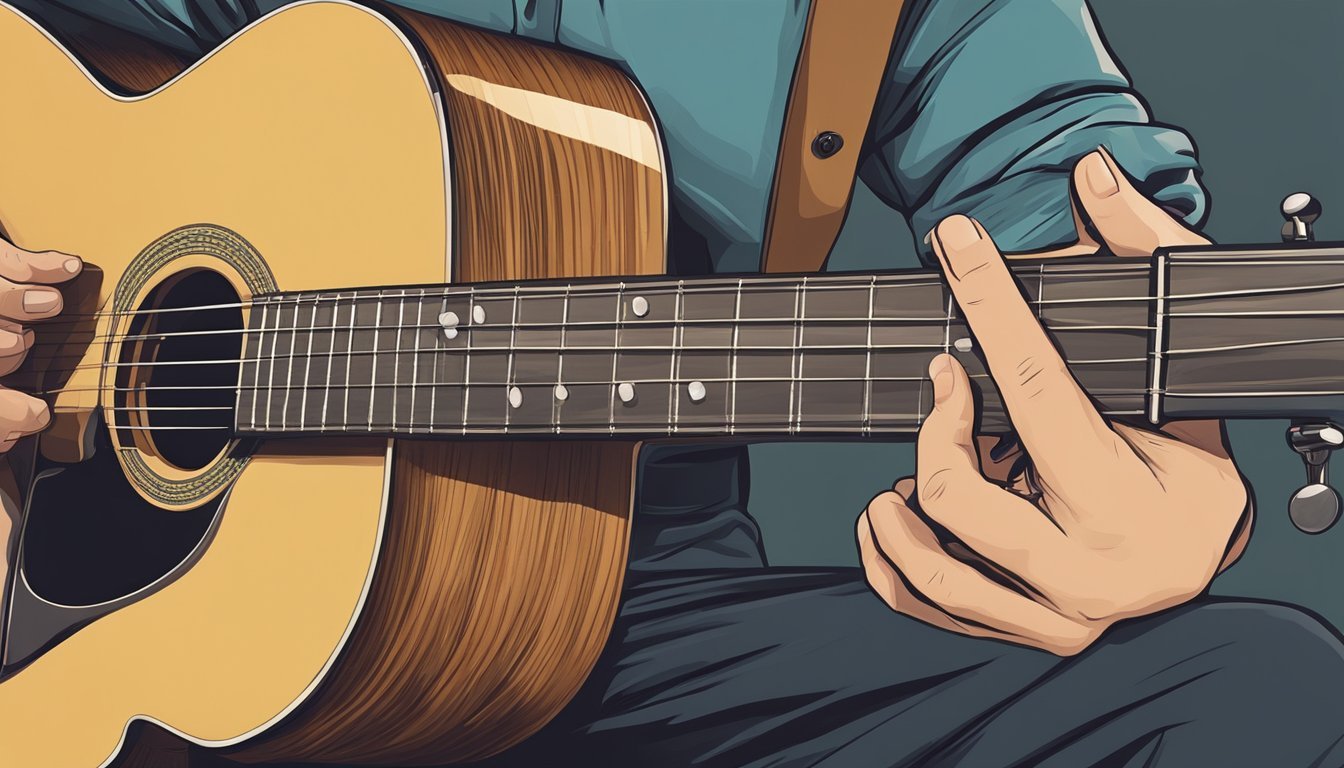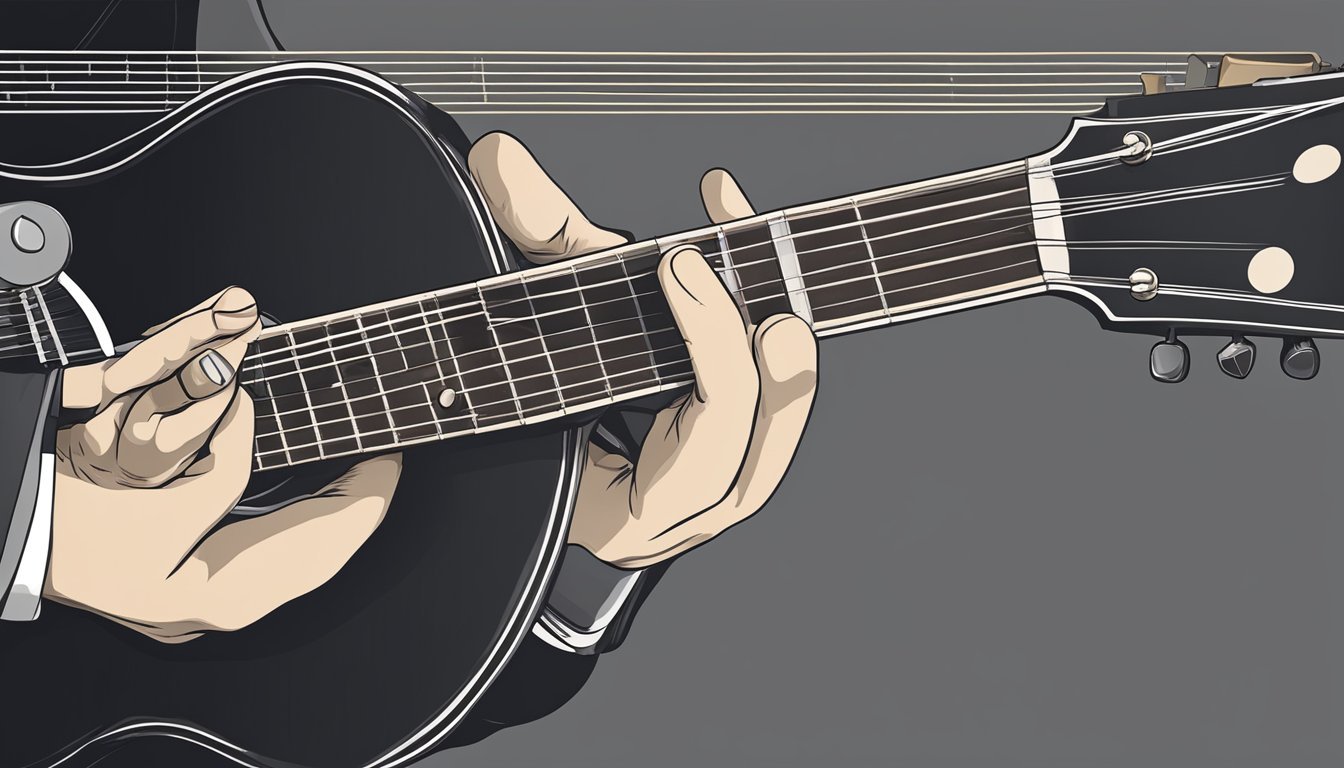Learning how to play the G chord on guitar can open up a world of music for you.
This chord is foundational and often used in many popular songs, making it a must-know for any guitarist.
Whether you’re a complete beginner or have some experience, getting comfortable with different ways to play the G chord will enhance your guitar skills.

As you explore various positions and strumming techniques, you’ll find that playing the G chord is not only satisfying but also fun.
You can experiment with simpler versions if you’re just starting out or dive into more complex variations as you progress.
This versatility means you’ll always have something new to try.
So grab your guitar and let’s get started on mastering the G chord! You’ll be playing your favorite songs in no time.
Key Takeaways
- The G chord is essential for many songs.
- There are multiple ways to play the G chord, perfect for any skill level.
- Practicing various strumming techniques can improve your overall guitar skills.
Getting to Know the G Chord
Playing the G chord is an important step in your guitar journey.
This section will cover the basics of the G Major chord, how to properly position your fingers, and the open G chord shape that you’ll use often.
Understanding the Basics of G Major
The G Major chord is a fundamental chord in music.
It serves as the first chord in the key of G Major.
You’ll find it used in countless songs across different genres.
The G chord is made up of the notes G, B, and D. When strummed together, these notes create a full, rich sound that is pleasing to the ear.
Many songs use G Major as a base, making it really useful to learn.
You’ll often switch between G and other major chords like C and D, which creates great harmony.
Finger Placement and Chord Shape
To play the G chord, finger placement is key.
Start by using your middle finger to press down the 3rd fret of the low E string.
Then, place your index finger on the 2nd fret of the A string.
Next, place your ring finger on the 3rd fret of the B string, and your pinky finger on the 3rd fret of the high E string.
Make sure to strum from the low E string down to the high E string while applying even pressure on the strings.
Once you’re comfortable with this chord progression, you’ll be ready to learn how to play hallelujah on guitar, which incorporates this G chord in its beautiful melody.
Use your ring finger to press the 3rd fret of the B string.
Finally, your pinky goes on the 3rd fret of the high E string.
Leave the D and G strings open, which means you do not press them down.
This setup makes the G chord sound full.
Practice this placement until it feels comfortable.
Playing the Open G Chord
The open G chord is probably the most common way to start playing.
It involves using the fingers in the way explained above while allowing some strings to ring freely.
You strum all six strings for a complete sound.
Make sure your fingers don’t accidentally mute any strings.
As you play, listen to the clear notes.
Strumming too hard can create a muddled sound, so go easy at first.
As you get better, your strumming will naturally improve.
Practicing the open G chord regularly will help you master it quickly.
Soon, you’ll be able to switch between it and other chords with ease!
Diving into Strumming Techniques
Strumming is a key part of guitar playing that helps bring chords to life.
Knowing how to mix up your strumming patterns and transition smoothly between chords will elevate your skills.
Mastering Strumming Patterns
When you strum, think of it as the rhythm of your music.
Start with simple downstrokes on every beat.
This means strumming downward across the strings, keeping it steady.
Once you’re comfortable, try adding upstrokes.
For example, a basic pattern could be down, down-up, up, down-up.
Practice this repeatedly.
Another thing to remember is to keep your wrist relaxed, which allows for smoother strumming.
You can also experiment with different patterns to match the style of the song you’re playing.
For instance, learning the classic strumming techniques for acoustic guitar can help you develop a unique sound.
Transitioning Between Chords
Smooth chord transitions are crucial, especially when switching between the G chord, C chord, and D chord.
Focus on the placement of your fingers on the guitar neck.
When moving from G to C, try to keep your fingers close to the strings.
This saves valuable time.
A helpful tip is to always anticipate your next chord.
Practice transitioning slowly at first, then gradually increase your speed.
Use a metronome to stay on beat and boost your timing.
Consistency is key, and with enough practice, you’ll find your transitions will become more fluid and natural.
Exploring Varied G Chord Positions
When playing the G chord on guitar, there are many ways to approach it.
Exploring different positions helps you find what sounds best for your style.
You can master barre chords and discover G major variations to expand your skills.
Barre Chord Mastery
Barre chords are a powerful tool in your guitar playing.
To play a G barre chord, you position your first finger across all the strings at the 3rd fret.
- Place your index finger on the 3rd fret of the E string.
- Use your other fingers to form the E major shape below the barre.
This gives you a full and rich sound.
Practicing this shape builds finger strength and flexibility.
Move this shape up and down the neck for other chords.
A common variation is to play a G7 barre chord, which adds a distinct sound.
To do this, lift your ring finger from the 3rd fret of the E string.
This small change makes a big difference!
Discovering G Major Variations
Variations of the G chord can really spice up your playing.
Start with the classic open G chord where you place your fingers as follows:
- Index on 2nd fret of the A string.
- Middle finger on 3rd fret of the low E string.
- Ring finger on 3rd fret of the high E string.
You can also try the G6 chord.
To play it, simply add your pinky to the 3rd fret of the B string while keeping the other fingers in place.
Another fun shape is the G major barre chord.
This uses the barre technique but adjusts your finger positions for a different sound.
This way, you not only master the basic G chord but also find ways to keep your music fresh and exciting.
Enhancing Your Guitar Skills

Improving your guitar skills involves exploring different techniques and applying music theory.
By blending fingerpicking, scales, and chord substitutions, you can elevate your playing.
Let’s dive into these methods.
Incorporating Scales and Triads
Using scales like the G major scale can enhance your soloing and improvisation.
Start by practicing the scale up and down the fretboard.
This will help you become familiar with the notes and their positions.
Next, integrate triads into your playing.
A major triad consists of three notes: the root, third, and fifth.
For G major, these notes are G, B, and D. You can play triads on different strings and positions to add variety to your music.
Additionally, try combining the G major pentatonic scale with triads.
This mix allows you to create smoother melodies and fills.
Practice this alongside your favorite songs to hear how they fit.
Fingerpicking and Chord Substitutions
Fingerpicking adds a unique feel to your playing.
To start, practice simple patterns on the G chord.
Use your thumb for the bass notes and your fingers for the higher strings.
This technique can create a more melodic sound.
You should also explore chord substitutions.
For example, instead of always playing the G chord in its standard form, try a different voicing.
This can keep your music fresh.
A great substitution for the G chord is playing a G7, which adds a bluesy feel.
Experiment with fingerpicking patterns using the G major blues scale.
This gives you a cool sound while enhancing your rhythm.
Use these techniques regularly in practice to build confidence and skill.
Frequently Asked Questions
Here are some common questions about playing the G chord on guitar.
Whether you’re just starting or looking to improve, these answers can help.
What’s the easiest way to strum a G chord for newbies?
For beginners, the best way to strum a G chord is to start slowly.
Use a simple downstroke with your pick or fingers.
Make sure you strum all six strings evenly.
Once you feel comfortable, you can experiment with different strumming patterns.
Got any cool variations of the G chord to spice things up?
Yes! Some fun variations of the G chord include the G7 and Gadd9.
These variations add different sounds and can make your playing more interesting.
It’s a great way to keep your guitar practice fresh.
What’s the difference between using 3 or 4 fingers for the G chord?
Using three fingers gives you a basic G chord, while using four fingers can create a fuller sound.
The four-finger G chord uses your pinky on the high E string.
This extra finger might feel tricky at first but adds depth to your playing.
Can you break down the G chord into simple steps for me?
Sure! To play a basic G chord:
- Place your middle finger on the 3rd fret of the low E string.
- Put your index finger on the 2nd fret of the A string.
- Next, place your ring finger on the 3rd fret of the B string.
- If you want the fuller sound, add your pinky to the 3rd fret of the high E string.
Make sure to strum all six strings!
What are some common mistakes to avoid when playing a G chord?
A common mistake is not pressing down hard enough on the strings.
This can cause buzzing sounds.
Another mistake is strumming the wrong strings.
Make sure to hit all the strings that are part of the chord for the best sound.
Know any tricks for switching to a G chord smoothly from C or D?
To switch smoothly to a G chord from C or D, you should practice the movement slowly.
Keep your fingers close to the fretboard to minimize movement.
Try to visualize the shape of the G chord in your mind as you transition.
With enough practice, it will feel more natural!

